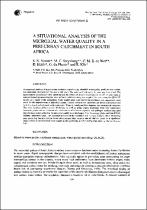 ResearchSpace
ResearchSpace
Situational analysis of the microbial water quality in a peri-urban catchment in South Africa
JavaScript is disabled for your browser. Some features of this site may not work without it.
- ResearchSpace
- →
- Research Publications/Outputs
- →
- Journal Articles
- →
- View Item
| dc.contributor.author |
Venter, SN

|
en_US |
| dc.contributor.author |
Steynberg, MC

|
en_US |
| dc.contributor.author |
De Wet, CME

|
en_US |
| dc.contributor.author |
Hohls, D

|
en_US |
| dc.contributor.author |
Du Plessis, G

|
en_US |
| dc.contributor.author |
Kfir, A

|
en_US |
| dc.date.accessioned | 2007-03-26T09:00:55Z | en_US |
| dc.date.accessioned | 2007-06-07T10:07:54Z | |
| dc.date.available | 2007-03-26T09:00:55Z | en_US |
| dc.date.available | 2007-06-07T10:07:54Z | |
| dc.date.copyright | en_US | |
| dc.date.issued | 1997 | en_US |
| dc.identifier.citation | Venter, SN, et al. 1997. Situational analysis of the microbial water quality in a peri-urban catchment in South Africa. Water Science and Technology, vol. 35, 12-November, pp 119-124 | en_US |
| dc.identifier.issn | 0273-1223 | en_US |
| dc.identifier.uri | http://hdl.handle.net/10204/2037 | en_US |
| dc.identifier.uri | http://hdl.handle.net/10204/2037 | |
| dc.description.abstract | A situational analysis of a peri-urban catchment experiencing microbial water quality problems was carried out using data collected over two and a half years. The water and land use in the area was determined. The main sources of pollution were identified and the effects of dilution and bacterial die-off on water quality were evaluated by modelling the level of faecal coliforms along the length of the river using the QUAL2E model. As a result of the assessment, water quality goals were set for the catchment and suggestions were made for the improvement of microbial quality. Certain areas of the catchment are densely populated and both developed and informal settlements exist. Water is mainly used for domestic and recreational purposes. The river receives diffuse source discharges as well as point source discharges from four wastewater treatment plants and an industrial site. Assessment of indicator organism and pathogen analyses indicated that the main factors affecting the microbial quality were discharges from the sewage plants and runoff from informal settlement areas. The industrial activities in the catchment did not have a major effect. Modelling runs predicting faecal coliform levels demonstrated that bacterial die-off did not result in a significant improvement to the microbial water quality in the catchment. | en_US |
| dc.format.extent | 283030 bytes | en_US |
| dc.format.mimetype | application/pdf | en_US |
| dc.language.iso | en | en_US |
| dc.publisher | Pergamon-Elsevier Science Ltd | en_US |
| dc.rights | Copyright: 1997 Pergamon-Elsevier Science Ltd | en_US |
| dc.source | en_US | |
| dc.subject | Microbial water quality | en_US |
| dc.subject | Catchment management | en_US |
| dc.subject | QUAL2E | en_US |
| dc.subject | Water quality modelling | en_US |
| dc.title | Situational analysis of the microbial water quality in a peri-urban catchment in South Africa | en_US |
| dc.type | Article | en_US |
| dc.identifier.apacitation | Venter, S., Steynberg, M., De Wet, C., Hohls, D., Du Plessis, G., & Kfir, A. (1997). Situational analysis of the microbial water quality in a peri-urban catchment in South Africa. http://hdl.handle.net/10204/2037 | en_ZA |
| dc.identifier.chicagocitation | Venter, SN, MC Steynberg, CME De Wet, D Hohls, G Du Plessis, and A Kfir "Situational analysis of the microbial water quality in a peri-urban catchment in South Africa." (1997) http://hdl.handle.net/10204/2037 | en_ZA |
| dc.identifier.vancouvercitation | Venter S, Steynberg M, De Wet C, Hohls D, Du Plessis G, Kfir A. Situational analysis of the microbial water quality in a peri-urban catchment in South Africa. 1997; http://hdl.handle.net/10204/2037. | en_ZA |
| dc.identifier.ris | TY - Article AU - Venter, SN AU - Steynberg, MC AU - De Wet, CME AU - Hohls, D AU - Du Plessis, G AU - Kfir, A AB - A situational analysis of a peri-urban catchment experiencing microbial water quality problems was carried out using data collected over two and a half years. The water and land use in the area was determined. The main sources of pollution were identified and the effects of dilution and bacterial die-off on water quality were evaluated by modelling the level of faecal coliforms along the length of the river using the QUAL2E model. As a result of the assessment, water quality goals were set for the catchment and suggestions were made for the improvement of microbial quality. Certain areas of the catchment are densely populated and both developed and informal settlements exist. Water is mainly used for domestic and recreational purposes. The river receives diffuse source discharges as well as point source discharges from four wastewater treatment plants and an industrial site. Assessment of indicator organism and pathogen analyses indicated that the main factors affecting the microbial quality were discharges from the sewage plants and runoff from informal settlement areas. The industrial activities in the catchment did not have a major effect. Modelling runs predicting faecal coliform levels demonstrated that bacterial die-off did not result in a significant improvement to the microbial water quality in the catchment. DA - 1997 DB - ResearchSpace DP - CSIR KW - Microbial water quality KW - Catchment management KW - QUAL2E KW - Water quality modelling LK - https://researchspace.csir.co.za PY - 1997 SM - 0273-1223 T1 - Situational analysis of the microbial water quality in a peri-urban catchment in South Africa TI - Situational analysis of the microbial water quality in a peri-urban catchment in South Africa UR - http://hdl.handle.net/10204/2037 ER - | en_ZA |





